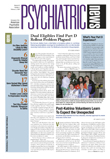How do you prepare your practice to be ready to respond in the event of a disaster—from something small scale like a computer crash to the kind of destruction associated with hurricanes Katrina and Rita? A prompt, effective, and confident response to an emergency or emergent situation can mean the difference between considerable damages or minimal damages.
Psychiatrists and other health care professionals are accustomed to planning for and responding to medical emergencies in acute-care settings. Once in an office setting, however, many professionals fail to recognize the need for emergency planning. But injuries and damages resulting from disasters in an office setting can be just as devastating as those arising in a hospital, and advance planning, staff training, and periodic reviews can assure an effective response in even the most modest of practice settings.
The goals of an emergency plan are to minimize the probability of injury or loss related to patients, visitors, or employees; prevent or decrease risk of property loss (equipment, patient and business records, and so on), and expedite recovery from the disaster.
For most psychiatric office settings, emergency plans do not have to be lengthy, and the planning and preparation should not be time consuming. The following suggestions may assist you with planning, constructing, and implementing an emergency plan:
1.
Begin by identifying and analyzing potential emergency risks.
•
Think about the activities in your office and the individuals and groups involved in those activities. Some examples are patients and families, professional staff, administrative staff, visitors, individual or group therapy, acupuncture, and lab work.
•
Consider specific types of emergencies that might occur, for example, medical emergencies, psychiatric emergencies, fire, bomb threats, hazmat exposure, flood, weather-related emergencies, and power outages.
•
Consider other factors that might contribute to an emergency and your ability to respond. Among these are special needs and requirements for the safety of staff and patients with disabilities.
2.
Weigh possible effective responses to the potential emergency situations identified and decide which responses are best for your practice setting. For example, you have identified flooding as a potential emergency situation to plan for because your office building has experienced problems with this during severe storms. Your analysis finds that the biggest potential risk/loss is the loss of patient and business records. After reviewing possible responses to minimize this risk, you develop a plan to
•
have electronic back-up records taken weekly to a secure off-site location,
•
transport active patient records to a safe location when a severe storm is imminent, and
•
store inactive patient records with a medical-record storage company. You decide against purchasing file cabinets advertised as waterproof and fireproof due to cost.
3.
Consider what safety features and plans may already be in place and incorporate them into your plan. Some examples to assess include any security procedures for the building; existence of an evacuation plan, fire plan, and so on; the emergency contact person if anything goes wrong in the building or if a problem is anticipated; presence of fire and other alarms; and the regularity with which fire extinguishers are checked.
4.
Prepare a written emergency plan. The plan should be readable and stored in an easily accessible location.
5.
Educate office staff about the emergency plan. All staff should know the location of the written emergency plan. They should also review the plan and have in-service training on responding to emergencies at least yearly. Staff members should be involved in identifying potential emergencies and updating the plan.
6.
Periodically review the plan and update it as needed. Keep staff informed of any changes.
7.
Have a contingency plan for what staff and others should do if you are not available. Doctors must prepare a set of instructions for staff, family members, and willing colleagues regarding what they should do in the event of the psychiatrist's sudden incapacity. The plan need not be complex but should be documented, be readily available to those who may need to implement it, and be regularly updated. A list of suggested items to be covered in a contingency plan includes the following:
•
Contact information such as the physician's pager number, cell phone number, home phone number, e-mail address, and home address.
•
Contact information for the physician's spouse, life partner, adult children, or anyone else who would likely know of the physician's whereabouts or sudden health problems.
•
A statement that staff is authorized to contact these people in the event of the physician's unexplained absence from the practice.
•
Instructions regarding how long staff should wait before implementing the emergency contact plan in the event of any unexplained absence. One hour is probably the longest period of unexplained absence the plan should allow.
•
Instructions regarding who is authorized to have access to patient records in the physician's unexplained absence. These instructions also should specify what information can be released from the records.
•
Instructions regarding prescription refills and release of information to third parties.
•
Instructions regarding how to deal with patients who become distressed, either physically or emotionally, in a crisis.
•
Names, addresses, and phone numbers of psychiatrists who have agreed to act as emergency backups. There should be more than one. Staff should be trained on proper referral procedures and proper termination-of-care procedures.
The emergency plan for any practice will be unique to the needs of that practice. There is a variety of resources available to help in your planning process. Among them:
•
American Health Information Management Association,<www.ahima.org> under “Practice Brief: Disaster Planning for Health Information”
•
Federal Emergency Management Agency,<www.fema.gov>
•
American Red Cross,<www.redcross.org/services/disaster/beprepared/busi_industry.html>
•
U.S. Department of Homeland Security,<www.ready.gov/business/index.html>. The department has posted information on costs that may be expected for emergency planning and protection at<www.ready.gov/business/over-cost.html>.
(Parts of this article were excerpted from the spring 2002 issue of Rx for Risk.) ▪
